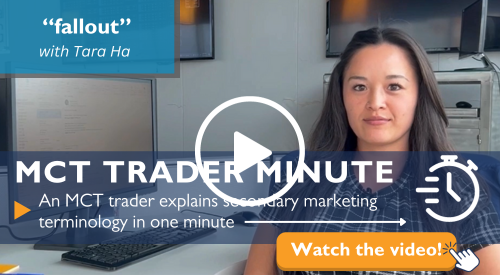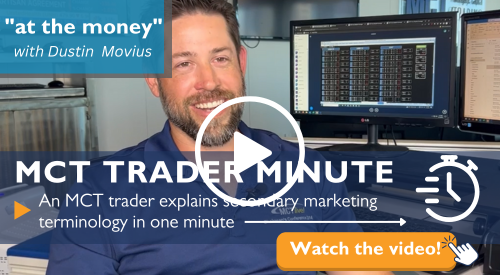Secondary Mortgage Market Glossary & Definitions

Our secondary mortgage marketing glossary outlines useful definitions for the mortgage industry’s most-used terms and phrases. On this page you can view our list of top secondary marketing terms & definitions.
We recommend you subscribe to our Market Commentary and Join our Newsletter for additional insight into what is the secondary mortgage market to help you succeed in the industry.
Ready to Learn More? Explore Secondary Market Education
Secondary Mortgage Market Definitions & Glossary
Accrual Based Accounting – An accounting process that charges income and expenses at the time they are generated instead of when the payment is received or made.
At the Money – In the context of options trading, the point at which the strike price is equal to the market price of the underlying security.
AOT – Assignment of Trade – In the context of the sale of mortgage loans, this is a
 transaction where the originator sells a loan or pool of loans to an investor while simultaneously assigning an appropriate and acceptable open TBA trade the originator has on with a broker dealer to the investor. The execution price the investor would pay the originator gets market adjusted for the movement of the trade(s) being assigned over to produce the final adjusted price. This process then eliminates the bid/ask spread that the originator would normally expect to incur from the broker dealer from pairing out of the trades themselves rather than assigning.
transaction where the originator sells a loan or pool of loans to an investor while simultaneously assigning an appropriate and acceptable open TBA trade the originator has on with a broker dealer to the investor. The execution price the investor would pay the originator gets market adjusted for the movement of the trade(s) being assigned over to produce the final adjusted price. This process then eliminates the bid/ask spread that the originator would normally expect to incur from the broker dealer from pairing out of the trades themselves rather than assigning.
Learn more about AOT’s in this blog post, Assignment of Trade (AOT) Executions 101 written by MCT AOT experts.
Basis Risk – The risk that two related markets will nonetheless not move in lockstep with each other, creating financial risk for parties that hold opposite positions in the two markets. For example, hedging mortgages with treasuries creates the risk that mortgage prices will decline faster than treasury prices in a market sell off. When you are hedging mortgages with TBA’s you are essentially eliminating most of the basis risk, which is why it is generally the preferred vehicle for hedging.
Bear Market – A market characterized by falling prices for the asset in question.
Bid – A price quote provided to a party that is looking to sell a position or asset. For example, to establish a position hedging new locks that are in the originator’s pipeline, a secondary marketing analyst would contact a broker/dealer and ask for a “bid” on a FNMA 4.0% TBA.
Bid-Ask Spread – The difference in price between the bid and offer quotations, which strongly influences transaction costs associated with trading and hedging positions.
Broker/Dealer – A regulated entity that provides market liquidity in the form of bid and offer quotations on financial positions including TBA’s.
Bulk MSR Bid – A bid to purchase a portfolio of the MSRs associated with seasoned loans.
Bulk Whole Loan Bid – A bid from a correspondent lender to purchase (typically) new loans.
Bull Market – A market is characterized by rising prices.
Sign Up to Go Beyond MCT’s Secondary Mortgage Marketing Glossary
Expand your knowledge of the secondary loan market by joining our newsletter for educational articles and timely market updates. With the MCT newsletter, you’ll remain well-informed on all secondary market home loans news, such as market trends, market activity, best practices, and more!
Customize Your Newsletter Content
- General & Newsletter – General information and news from MCT.
- Educational Articles & Whitepapers – Market trends, data analysis, capital markets coverage, and best practices recommendations.
- Market Commentary – Latest news and commentary on market activity from MCT experts. Sent daily when the market is open.
Mortgage Glossary & Definitions Continued
Call Option – A contract granting the right, but not the obligation, to purchase an asset at a designated “strike price” for a specific period of time.
designated “strike price” for a specific period of time.
Cash Basis for Accounting – A method of accounting where income and costs are booked at the time cash is received or paid.
Co-Issue – A three way transaction involving the sale of loans to one of the agencies with a simultaneous sale of servicing to a separate third party (the “co-issue buyer”).
Convexity – Measures the change in the duration of an asset given a move in interest rates.
CPR Prepayment Curve – CPR (the conditional prepayment curve) represents a constant rate of prepayment, usually measured on an annual basis. It differs from the PSA prepayment curve because it is one unchanged rate over the life of the loan or portfolio.
Cross Hedge – The hedge of an asset with an instrument having different characteristics. Differences can include product or coupon and exposes the position to basis risk.
Differences can include product or coupon and exposes the position to basis risk.
Derivative – An instrument whose price and performance is “derived” from the performance of another instrument.
Direct Trade – A lender negotiates a commitment to sell a loan or group of loans directly to the investor with specific terms.
Duration – Measures  the sensitivity of a bonds price to the changes in interest rates.
the sensitivity of a bonds price to the changes in interest rates.
Excess Servicing – An interest cash flow that remains after accounting for required servicing and the coupon into which the security is pooled with the agencies.
Fallout – In the context of mortgage loan pull through, the percentage of loans in a pipeline that are canceled, withdrawn, or denied in the loan pipeline prior to closing.
that are canceled, withdrawn, or denied in the loan pipeline prior to closing.
Forward Commitment – A commitment by a seller to deliver an asset or commodity at a designated price and specified time in the future.
Guarantee Fee (“G-Fee”) – A payment made to the agencies from the mortgage’s interest payments that compensates the agencies for insuring the credit performance of the loans in a pool.
There are many benefits to hedging your loan sales that outweigh the risks associated. With our hedge advisory services, our team of experts work with your secondary market staff to create a daily cycle of disciplines for successful pipeline management.
Sign Up to Go Beyond MCT's Secondary Mortgage Marketing Glossary
Expand your knowledge of the secondary mortgage market by joining our newsletter for educational articles and timely market updates. With the MCT newsletter, you'll remain well-informed on market trends, market activity, best practices, and more!
Customize Your Newsletter Content
- General & Newsletter - General information and news from MCT.
- Educational Articles & Whitepapers - Market trends, data analysis, capital markets coverage, and best practices recommendations.
- Market Commentary - Latest news and commentary on market activity from MCT experts. Sent daily when the market is open.
Mortgage Glossary & Definitions Continued
Daily and monthly Mark-to-Market reporting engenders the transparency and control that mortgage companies need to be fully prepared for any market event. Learn more in this blog post about the reporting and services of MCT's Product and Pricing group.
Interest rates can change between the time a borrower locks their interest rate to when the loan is actually funded which can leave you at risk.
Learn how to-be-announced (TBA) mortgage backed securities (MBS) are used as financial tools to hedge lenders' mortgage pipelines in this Introduction to Mandatory Loan Sale Delivery blog post.
Works Cited
“Financing Glossary of Terms.” Cambridge Realty Capital, www.cambridgecap.com/infocenter/financing-glossary-terms/. “What’s What in the Financial Services Industry.” SOS: Broker Dealer Agent, www.in.gov/sos/securities/3471.htm. Staff, Investopedia. “Assignment of Trade (AOT).” Investopedia, Investopedia, 13 Feb. 2018, www.investopedia.com/terms/a/assignment_of_trade.asp. “Mortgage Glossary.” Mortgage Glossary | Mortgage Terms | Adventure Credit Union, www.adventurecu.org/explore/tools-resources/mortgage-glossary.






